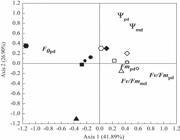ABSTRACT
Among the effects of environmental change, the intensification of drought events is noteworthy, and tropical vegetation is predicted to be highly vulnerable to it. However, it is not clear how tropical plants in drought-prone habitats will respond to this change. In a coastal sandy plain environment, we evaluated the response of six plant species to water deficits across seasons, the relationship between their morpho-physiological traits, and which traits would be the best descriptors of plants' response to drought. Regardless of leaf succulence and phenology, responses between seasons were most strongly related to chlorophyll fluorescence. In this study we have demonstrated that a better comprehension of how tropical species from drought-prone habitats cope with changes in water availability can be based on seasonal variation in leaf water potential and chlorophyll fluorescence. Temporal variation in leaf water potential and chlorophyll fluorescence was found useful for differentiating between groups of sandy soil species that are responsive or unresponsive to water availability. However, chlorophyll fluorescence appeared to be a more sensitive descriptor of their seasonal and short-term responses.
Key words:
drought; functional traits; plant-water relations; photoinhibition; seasonal habitats

 Thumbnail
Thumbnail
 Thumbnail
Thumbnail
 Thumbnail
Thumbnail
 Thumbnail
Thumbnail









